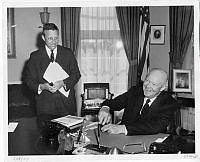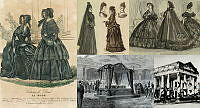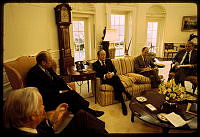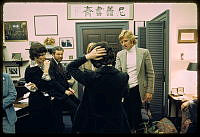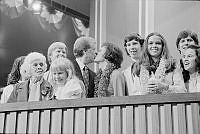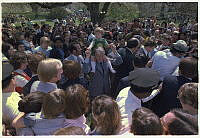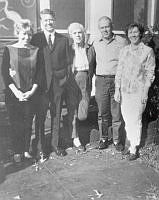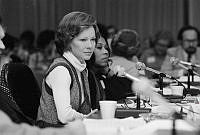"Articles of the Best Kind"
James Monroe Furnishes the Rebuilt White House
Copyright © June 01, 2014 White House Historical Association. All rights reserved under international copyright conventions. No part of this article may be reproduced or utilized in any form or by any means, electronic or mechanical, including photocopying, recording, or by any information storage and retrieval system, without permission in writing from the publisher. Requests for reprint permissions should be addressed to books@whha.org
The drawing-room and suite of rooms at the President’s are furnished and decorated in the most splendid manner; some think too much so, but I do not. Something of splendor is certainly proper about the Chief Magistrate for the credit of the nation. Plainness can be carried to an extreme, and in national buildings and establishments it will, with good reason, be styled meanness.
When on March 4, 1817, James Monroe was inaugurated as the fifth president of the United States, the District of Columbia still bore scars from its sacking by the British three years earlier. The country had achieved few of the political and military aims that led it into the War of 1812, and having the capital torched by the enemy caused profound national embarrassment. Andrew Jackson’s victory over the British at New Orleans had helped the country overcome this negative view of the war, and the postwar national mood became optimistic. Americans characterized the war as a “second American Revolution” that solidified independence from Great Britain.1 Monroe’s election as a Republican, which coincided with the decline of the Federalists as a national political party, presaged a period called the “Era of Good Feelings.”2 While the term more accurately reflected a political realignment than true bipartisanship, Monroe hoped that the collapse of the Federalists as a national party would bring an end to the divisiveness caused by party politics.3
In addition to political harmony, James Monroe—himself an experienced diplomat—was also committed to asserting the power and prestige of the United States at home and abroad. A key symbol of this endeavor was the White House.4 Reconstruction of the mansion was supervised by the original architect of the house, James Hoban, but Monroe took an active interest in the organization and execution of the work. He would also become deeply involved in acquiring interior furnishings suitable to the revitalized White House.5

President James Monroe’s portrait by Samuel F. B. Morse hangs in the Blue Room of the White House today, overlooking many of the “articles of the best kind” he acquired to furnish the newly rebuilt White House.
Bruce White For The White House Historical AssociationMonroe placed orders for furnishings with craftsmen at home and abroad soon after taking office, but he noted the immediate need for suitable furniture in a letter dated April 28, 1817, (coincidentally, his 59th birthday) to Colonel Samuel Lane, commissioner for the District of Columbia:
"It appearing, after the order sent to France, & the contracts already made here & in Phila., that there will be a considerable deficiency, in the sum appropriated for furniture for the President’s house, and there being little if any on hand fit for immediate use; it may be advisable to retain from my furniture, such articles as may be found proper and indispensible.
"I have a small service of excellent plate, made for my own use, by the best artists in France and England, which with the articles I have now ordered from France, and those to be manufactured out of the old plate, will make a full service, such as is commonly used in France, for the President’s house. I have also dining room, drawing & bed room furniture, French china, glass, and kitchen furniture, all of good quality and in good state. I am willing to dispose of those articles, at the price at which they may be valued, by two citizens of the first respectability, assisted by persons skilled in the manufacture of each article, or I will dispose of the plate only, by valuation, there being but few purchases of that article, and of all the others at public sale, as you may think advisable. I enclose you a list of those articles; they are still in the house I lately occupied, and will be delivered to you, by one of my servants, who attends there for the purpose.
"I shall be content to wait for payment until another appropriation is made, or to retake my own furniture, should no appropriation be made, my object being to supply the present demand, in a mode, by which the public cannot lose, and to apply the money, when appropriated, in the purchase of articles of the best kind, & on the best terms, for the new buildings, which it is expected will be finished by the time they arrive."6

The Folie de Bouëxiére, Monroe’s home in Paris, has been demolished but is reimagined here by contemporary artist Christian Bénilan. Many of the furnishings purchased by the Monroes for this diplomatic residence were also used in their subsequent homes, including the White House.
Christian Benilan/christianbenilan.wifeo.comMuch of the furniture to which Monroe referred was obtained in France during his diplomatic postings. A secretary desk, chairs, commode, and related items were originally acquired for use in the Folie de la Bouëxiére, the Paris house Monroe purchased while serving as minister to France in the Washington administration (1794–96).7 The desk is the most noteworthy artifact, being celebrated as the Monroe Doctrine Desk.8
Utilizing his personal furniture in the White House solved a short-term problem for Monroe, but the financial implications of the arrangement were convoluted and ultimately troublesome. Congress had established a $20,000 Furniture Fund for the Executive Residence on March 3, 1817, to be administered by the president personally. Monroe entrusted day-to-day management of the fund to Commissioner Samuel Lane and also utilized as a buyer William Lee, the second auditor of the treasury. As compensation for use of his personal property, Monroe was paid $9,072.22½, $6,000 of which was disbursed from the Furniture Fund by Lane (the source of the remaining $3,072.22½ is unclear). Monroe used these proceeds to finance his tour of the northern states that took place from June to September 1817. Upon his return to the capital he repaid the $6,000, but then learned that the Furniture Fund was in trouble. 9

Tea table acquired in 1797 during President Monroe's service as Minister to France and subsequently used in all of the family's homes, including the White House.
Bruce White for the White House Historical Association/Collection of the James Monroe Museum and Memorial LibraryMonroe’s stated goal was to acquire “articles of the best kind, & on the best terms.” While largely successful in accomplishing the former, the latter proved more difficult. Joseph Russell and John LaFarge, the American agents contracted by the president to buy furnishings in France, ended up spending $18,417.17 just to outfit the oval saloon (known today as the the Blue Room). Although the term “sticker shock” had not yet been coined in Monroe’s day, it probably describes the president’s reaction to a report from Le Havre, France, dated September 15, 1817, that the agents submitted:
"Our Mr. Russell, having been detained in Bordeaux by business, transmitted us the orders he received from Your Excellency for the purchase of the Furniture for the palace of the President at Washington.
"Eager to satisfy the confidence with which Your Excellency has honored us in selecting a member of our House for that Commission, we have spared no pains in the execution of it.
"Our Mr. LaFarge went to Paris in the beginning of June for this purpose, where the results of his enquiries soon convinced him that there was no possibility of purchasing anything ready made, and in order to comply with the instructions of Your Excellency of 23rd April, he was under the necessity of ordering the whole of the Furniture to be made that he might be sure to obtain such Articles as united Strength with Elegance of Form, and combining at the same time, Simplicity of ornament with the Richness suitable to the Decoration of a House occupied by the first Magistrate of a free nation. . . .

Clothes storage commode acquired in 1797 during President Monroe's service as Minister to France and subsequently used in all of the family's homes, including the White House.
Bruce White for the White House Historical Association/Collection of the James Monroe Museum and Memorial Library"The satisfaction we feel in the execution of the Trust committed to our care will, we hope, on examining our Purchases, be shared by Your Excellency, for we may say with justice that every Article is of good quality and well conditioned. On the other hand, we are very sorry that we have not been able to confine ourselves within the limits allowed by Your Excellency, and that the sum exceeds even the Three thousand Dollars granted besides the Twelve thousand at first fixed. However we can assure Your Excellency that everything has been bought at the very lowest price, and that we have availed ourselves of all the resources which our exclusive connections with a great many Manufacturers of Paris affords us, for the most favorable conditions, added to the no small influence of paying in Cash, and so we are assured that the Manufacturers have had but a trifling profit; in comparison to what they generally get, some even are losers.
"There are many Articles bought under the price which Your Excellency had fixed, but one of the most important is the Furniture for the large oval room, which costs a great deal more than what Your Excellency had calculated and which is caused by the change which we have been obliged to make of Gilt Wood instead of Mahogany. The result of that substitution has been an increase of expense for the Furnishings of the Fauteuils, etc., and the Draperies of the curtains which must be richer that everything might be in harmony. We should also add that Mahogany is not generally admitted in the Furniture of a Saloon even at Private Gentlemen’s Houses." 10

Dessert console acquired in 1797 during President Monroe's service as Minister to France and subsequently used in all of the family's homes, including the White House.
Bruce White for the White House Historical Association/Collection of the James Monroe Museum and Memorial LibraryThe cost of the French furniture, as well as other pieces purchased in Washington, D.C., and Philadelphia, produced a deficit in the Furniture Fund of $11,000. Monroe requested and received from Congress a supplemental appropriation of $30,000. He used the Furniture Fund to finance another presidential tour, this time of the southern states in 1819. On this occasion Lane disbursed to Monroe the full $9,072.22½ value of his furniture, which the president regarded, in effect, as a provisional loan. Unfortunately, Samuel Lane’s bookkeeping was lax, if not fraudulent. When Lane died unexpectedly in 1822, Monroe was shocked to discover that he owed the commissioner’s estate $6,500 for expenditures made in the president’s name. Although he felt the amount was incorrectly high, Monroe paid the debt to Lane’s executors as a personal obligation. Still hoping to ultimately receive compensation for the use of his furniture, Monroe deferred any claims for final reimbursement until he left office and petitioned Congress to conduct an official investigation of all transactions related to furnishing the White House. A succession of House committees examined Lane’s and Monroe’s finances, often accompanied by partisan rhetoric that offered few “Good Feelings.”11 Monroe, a proud man who reacted forcefully when he believed his honor was questioned, complained that “Every kind of malignant effort is made to annoy me, by men of violent passions, some of whom are very ignorant, and others little restrained by principle.” 12

Silver dessert service flatware from the James Monroe Museum collection with mother-of-pearl handles. The knives bear the Monroe crest and were made by Samuel Pemberton, Birmingham, England, ca. 1805.
Bruce White for the White House Historical Association/Collection of the James Monroe Museum and Memorial LibrarySecretary of State John Quincy Adams was appalled by what he viewed as a vindictive and embarrassing assault on Monroe’s integrity:
"I read this day the President’s memoir upon the transactions relating to the appropriations for furnishing the President’s house. It enters into details of a very humiliating character, and which ought never to have been, or to be, required of him. There arises from all this an exposure of domestic and household concerns almost as incongruous to the station of a President of the United States as it would be to a blooming virgin to exhibit herself naked before a multitude." 13
The variety and scale of the items obtained in France were considerable. Renowned cabinetmaker Pierre-Antoine Bellangé crafted a thirty-eight-piece set of chairs, sofas, and other elements in the gilded beechwood mentioned by Russell and LaFarge. Here ornamental richness returned to an extent with carved laurel leaves and other trophé.
President Monroe also acquired silver plate; a dramatic 14-foot dining table centerpiece, or “plateau,” made of gilded bronze with mirrored platforms; two bronze clocks adorned with classical figures (Monroe specified no nudes); and a large crystal chandelier originally ordered by the French government and mistakenly thought by many White House visitors as having been used by Napoleon. 14

A plate from the Monroe dessert service with an eagle is included in the James Monroe Museum collection.
Bruce White for the White House Historical Association/Collection of the James Monroe Museum and Memorial Library
The Monroe dinner service has not been identified definitively, but may have included these pieces from a gilt-decorated set with an “M” inside a shield and an eagle surrounded by twenty stars now in the collection of the James Monroe Museum
Bruce White for the White House Historical Association/Collection of the James Monroe Museum and Memorial LibraryAmong the plethora of household items was the first set of china specifically commissioned for an American president. A porcelain dinner service of fifty-three settings and a dessert service were manufactured by the firm of Pierre-Louis Dagoty and Edouard D. Honoré of Paris, at a cost of $1,167.23. The Monroe dessert service is well-documented. An eagle clutching an olive branch and arrows in its talons is the central image, bearing a red, white, and blue shield draped with a banner reading “E Pluribus Unum.” The reddish-purple amaranth border contains five vignettes representing Agriculture, Arts, Commerce, Science, and Strength. The dinner service has never been identified definitively; candidates include a gilt-decorated set with an “M” inside a shield and an eagle surrounded by twenty stars, and pieces thought by some to be the dessert service of Andrew Jackson. The latter have blue-marbled bands with gilt edges and an ascendant eagle identical to that on the Monroe dessert service, though reversed. Family tradition holds that this set was used by the Monroes in the White House, and two cups from the service are in the collection of the James Monroe Museum and Memorial Library in Fredericksburg.15
The process of repairing and refurnishing the White House extended through both of James Monroe’s presidential terms, and after. The French influence evident in the material culture of the home was manifested also in his family’s style of entertaining, which favored formal “drawing rooms” (salons or evening receptions), largely devoid of dancing and other social diversions. In a Washington society still confined to a small number of government officials and their families, the imposition of such “foreign” customs generated considerable gossip and resentment. While most visitors were duly impressed by the richness of the furnishings in the Monroe White House, the fact that so many items were purchased abroad produced a pro-American backlash. On March 4, 1825, the day John Quincy Adams was sworn in as Monroe’s successor, the New England Palladium and Commercial Advertiser opined “We hope she [Louisa Catherine Adams] will study to adorn her residence with articles made solely by American Manufacturers. . . .We hope the inside of the President’s House, during the administration of Mr. Adams, may assume a national aspect. We have no doubt our mechanicks and manufacturers would make it vie in splendour with any in Europe.” This sentiment was translated into law when Congress passed an act in 1825 stipulating “that all furniture purchased for use of the President’s House shall be as far as practicable of American or domestic manufacture.” 16

Several pieces of furniture in the Monroe Room in 1931.
Herbert Hoover Presidential Library-MusuemThe passage of time and evolution of decorating tastes wrought further changes to the White House after the Monroes’ departure. While some items remained, much of the furniture, china, and textiles was lost either to damage or through auction sales in the administrations of Andrew Jackson, James Buchanan, and Chester A. Arthur.17 Theodore Roosevelt’s comprehensive overhaul of the White House in 1902 included chairs for the Blue Room that attempted to imitate, if on a larger scale, the Bellangé pieces of 1817. Jacqueline Kennedy’s 1961 campaign to recapture the home’s past grandeur focused largely on Monroe’s decor and included a concerted effort to bring back to the White House as many of the items he purchased as possible. A pier table from Pierre-Antoine Bellangé’s set of furniture still in the mansion was restored, several original chairs were reacquired, and additional reproductions were fabricated in New York. Subsequent refurbishments of the Blue Room were carried out in the Nixon and Clinton administrations, and conservation of original period pieces continues.18
Monroe’s refurnishing of the White House reflected his vision for the growing power and prestige of the United States. As the presidency was the pinnacle of the nation’s government, so, too, he felt must the President’s House be the symbolic expression of the nation’s ideals. The American presidency has no other stage upon which to present itself than this house. Monroe’s efforts to suitably outfit the White House caused him no small amount of personal and political discomfort, but he remained fixed upon his goal because he knew he was right. Perhaps this situation was on his mind when he commented on public responsibility in his annual message to Congress in 1823 (the same message that promulgated the Monroe Doctrine):
"We are all liable to error, and those who are engaged in the management of public affairs are more subject to excitement and to be led astray by their particular interests and passions than the great body of our constituents, who, living at home in the pursuit of their ordinary avocations, are calm but deeply interested spectators of events and of the conduct of those who are parties to them."19
Nearly two centuries have passed since James Monroe took the first steps to define his expression of White House style. Occasionally decried, but more often admired, the standard he set is one that contemporary first families have sought to preserve and perpetuate—an ongoing quest for “articles of the best kind.”

The Monroe Doctrine desk
Bruce White for the White House Historical Association/Collection of the James Monroe Museum and Memorial LibraryThe Monroe Doctrine Desk
A cornerstone of the James Monroe Museum’s collection, the Monroe Doctrine Desk is a mahogany fallfront secrétaire in the late Louis XVI style. The desk features a white marble top and pierced brass gallery. All four corners of the desk have fluted columns, fitted with brass inserts. The desk was part of a group of furniture purchased by Monroe while he was minister to France, 1794–96. It was used in the President’s House from 1817 to 1825 and later at Oak Hill, the Monroe family residence, from 1825 to 1830. While the maker has not been identified, the style is similar to that of Parisian ébenisté (cabinetmaker) Godefroy Dester (1768–1805). According to Monroe’s account books, in August 1794 he paid 4,000 livres for “furniture.”
The fall-front serves as a writing surface, and when laid flat, opens to reveal one large shelf over two smaller shelves. Tucked within the space are three small drawers on either side of a cubicle. The floor of the cubicle can be removed to reveal a compartment slightly less than a foot square and 3 inches deep.
According to family tradition, Monroe's
great-great-grandson, Laurence Gouverneur Hoes, climbed on the desk as a
child, causing the piece to fall forward. Laurence was unhurt, but
during the desk’s subsequent repair a cache of letters was discovered in
the cubicle compartment. Among the correspondents were Benjamin
Franklin, Thomas Jefferson, the Marquis de Lafayette, John Marshall,
James Madison, and George Washington.
Laurence Hoes later became
much better at handling artifacts. In 1927 he and his mother, Rose de
Chine Gouverneur Hoes, acquired the site of James Monroe’s
Fredericksburg, Virginia, law office. The next year they opened a museum
featuring items passed down through the family. Laurence Hoes scoured
the country for other Monroe-era artifacts, books, and documents during
fifty-one years as the first director of the James Monroe Museum and
Memorial Library. The museum was given to the Commonwealth of Virginia
in 1964, and today is administered by the University of Mary Washington.
In the 1930s, First Lady Lou Henry Hoover visited the James Monroe Museum at the invitation of Laurence Hoes. Mrs. Hoover was so impressed with the furniture on exhibit that she requested several of the late Louis XVI style pieces be copied for the Hoover White House. The desk, a pair of hanging shelves, and a flat-top writing table were reproduced by the Washington, D.C., cabinetmaker Morris W. Dove (1878–1968) in 1932 and installed upstairs in the former Cabinet Room of the White House, which Mrs. Hoover converted to a sitting area and called the Monroe Room.†
Prior to the Hoover renovation, the room was used as a waiting area and for cabinet meetings. After the Hoovers’ departure it was redecorated as the Rose Parlor and used by several first ladies. Eleanor Roosevelt held press conferences there, and Winston Churchill utilized the space as a traveling version of his World War II Map Room when staying at the White House. Known since the 1960s as the Treaty Room, it has been employed as a private office for the presidents beginning with George H. W. Bush and including Barack Obama.

Mrs. Hoover, c. 1932, seated at the reproduction of the Monroe Doctrine Desk.
White House Historical Association/White House Collection













